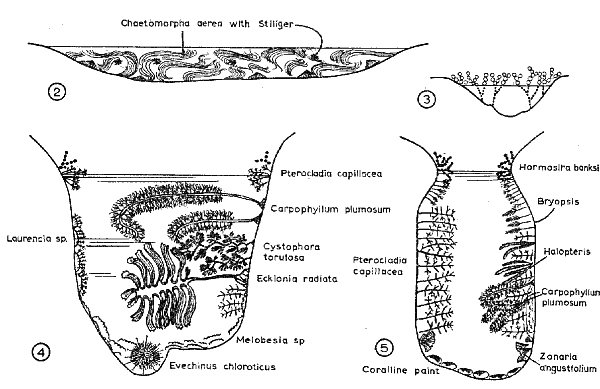 |
|
|
Habitats: rock poolwww.seafriends.org.nz/enviro/habitat/rockpool.htm
|
Deep rock pools provide shelter from waves, allowing fragile organisms to live on an otherwise exposed rocky shore. Fragile animals are: sea slugs, shrimps, camouflage crabs, sea eggs, small fishes. Fragile sea weeds are: neptune's necklace, pillow weed, cystophora, sea lettuce and many others.
For the snails that are able to survive in between high and low tide (periwinkle, nerita, melagraphia, cats eye) a rock pool is not necessarily a better place because their predators are found there (dark rock shell, white rock shell, trumpet shell). Large fish and octopus may find the rock pools too small, lacking oxygen for breathing. Rock pools may collect fresh water during rain storms, which is worse for shallow rock pools high up the shore where organisms must wait longer for the tide to return.
Warning! rich rock pools are rare. Treat them with care!
Many small fishes use the rock pool as a shelter against the low tide,
but as soon as the new tide moves in, they leave the pool to wander around
their much larger territories outside the pool, where they find their daily
food. Recent scientific research has shown that most of these small fishes
stay in the same pool all their lives. It is important to these fishes
that they can hide inside the pool, in a crevice, under an overhang or
under a large stone.
 |
Temperature
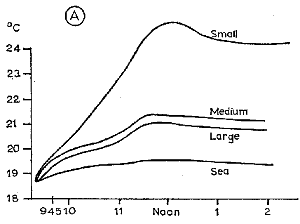 During
the day, rock pools are heated by the sun and warm up, but during the night
they are cooled. When water warms up, it does not pass the warmth downward
easily. A thermocline develops, which is a sharp boundary between the warm
water above and the cool water deeper down. It may explain some of a rock
pool's zoning.
During
the day, rock pools are heated by the sun and warm up, but during the night
they are cooled. When water warms up, it does not pass the warmth downward
easily. A thermocline develops, which is a sharp boundary between the warm
water above and the cool water deeper down. It may explain some of a rock
pool's zoning.
The graph shows the rate of warming for small to large rock pools.
Notice how the small pool warms up more so than the large ones, but all
even out at a maximum for the day. The temperature also depends on how
much water evaporates by the wind blowing over the pool.
Here in New Zealand, the difference between winter and summer temperatures in the sea is some 6-8 ºC but the difference between summer and winter air temperatures is much larger. A shallow rock pool can be heated to 40 ºC, a temperature that kills most shore creatures.
Salinity
As water evaporates from shallow pools, it leaves the dissolved minerals
behind in the remaining water. The sea's most common mineral is salt. So,
every rock pool becomes saltier as its water evaporates, but shallow pools
towards the high tide, more so than others. Some pools show salt crusts.
Very few if any animals or plants can live there.
When it rains, fresh water drains into the rock pools and depending on its volume, a rock pool can become too fresh for marine life. Fortunately, fresh water floats on top, being lighter than salt water. Because it mixes only when stirred vigorously, animals and plants can often survive deeper down.
Oxygen
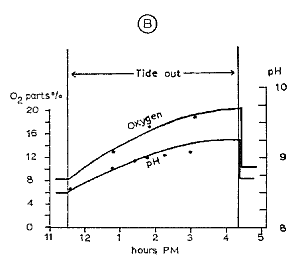 Animals
need oxygen for breathing, but plants also need oxygen at night when they
cannot make their own. So the low tide at night is the most critical. Fortunately
most animals are inactive at night, using the least possible amount of
oxygen.
Animals
need oxygen for breathing, but plants also need oxygen at night when they
cannot make their own. So the low tide at night is the most critical. Fortunately
most animals are inactive at night, using the least possible amount of
oxygen.
During the day, the plants may produce more oxygen than is used by
the animals and the oxygen level in the pool may rise, rather than fall.
See the graph on the right.
Sediment
Sediment makes the water murky, depriving plants from the light they
need. Sediment (like mud) also settles on the fine gills of all water breathing
animals, making them sick or suffocating them. When a lot of mud or sand
regularly washes into the rock pool, animals and plants are smothered and
the rock pool looks barren (See photo).
Light
Light enters the pool on an angle from above. Deep pools may show a
distinctly shaded side, inviting a variety of red seaweeds. Narrow, steep
pools may not get as much daylight as wide ones, inviting shade-tolerant
species to live near the bottom. Underneath stones and inside crevices,
where it is dark, one may find animals such as sponges and seasquirts,
that would otherwise not be able to compete with the plants on the sun-lit
surfaces.
People
People like rock pools, for bathing in or for studying. Nowadays so
many people visit the sea that the available rock pools are visited many
times a year. Even when visitors are very careful, the damage to these
often fragile organisms, may accumulate and become visible. So take utmost
care when visiting rock pools, particularly when turning stones.
Remember that a one off disaster can be more damaging than average unfavourable
conditions.
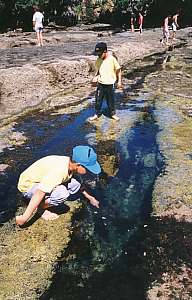
These rich, deep rock pools in the Goat Island marine reserve never fail to amaze. |
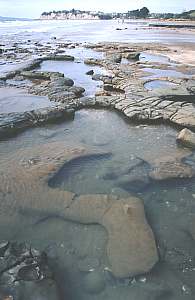 |
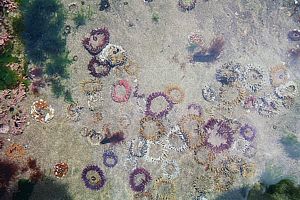 |
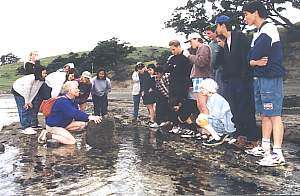 |
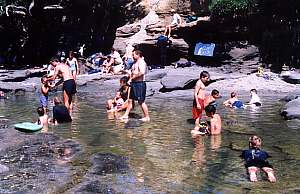 |
Diagrams from Morton & Miller, The New Zealand
Seashore. 1968. With permission.
Photos Floor Anthoni.